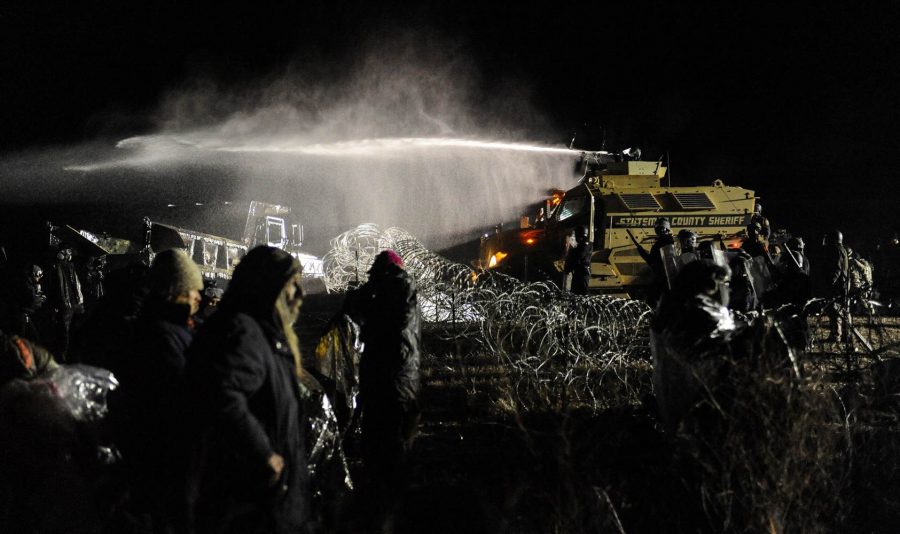North Dakota Access Oil Pipeline Controversy
The Army Corps of Engineers does not allow construction workers to build the Dakota Access Pipeline because it crosses Native American land.
December 21, 2016
North Dakota Access Oil Pipeline Controversy
On December 4, 2016, the Army Corps of Engineers denied an easement that would have allowed the Dakota Access oil pipeline to be built through Standing Rock, ND.
The decision comes after months of passionate, and sometimes violent protest against the project and is viewed by protesters as a victory for clean water and NativeAmerican rights. Supporters of the Standing Rock Sioux tribe claimed that the pipeline would contaminate the water source of Lake Oahe and trespass on sacredNative American ground.
“We wholeheartedly support the decision of the administration and commend with the utmost gratitude the courage it took on the part of President Obama, the ArmyCorps, the Department of Justice and the Department of the Interior to take steps to correct the course of history and to do the right thing,” said TribalChairman Dave Archambault II in a statement.
The decision came just a few days after protesters were ordered to leave the construction site under threat of military action. Over 2,000 veterans came toStanding Rock to form a human shield around the protesters and were prepared for a fight, one that luckily never came.
The Standing Rock Sioux tribe sued the Army Corps of Engineers this past July, a case that they ultimately lost.Around that time, protests began, some turning violent. Police also used violence in putting down the protesters, leading to an extremely tense situation at the construction site.
Construction was stalled on the pipeline by the Obama Administration to allow for a review of the pipeline, one which ultimately led to the decision to deny the easement.
However, the denial of the easement is not the decisive victory some activists make it out to be. The denial is only effective pending an environmental review, one which might occur under the incoming Trump administration, which has come out in support of the DakotaAccess Pipeline.
Still, the Standing Rock Sioux tribe and their supporters are celebrating their victory, however impactful it turns out.
The decision comes after months of passionate, and sometimes violent protest against the project and is viewed by protesters as a victory for clean water and Native American rights. Supporters of the Standing Rock Sioux tribe claimed that the pipeline would contaminate the water source of Lake Oahe and trespass on sacred Native American ground.
“We wholeheartedly support the decision of the administration and commend with
the utmost gratitude the courage it took on the part of President Obama, the Army Corps, the Department of Justice and the Department of the Interior to take steps to correct the course of history and to do the right thing,” said Tribal Chairman Dave Archambault II in a statement.
The decision came just a few days after protesters were ordered to leave the construction site under threat of military action. Over 2,000 veterans came to Standing Rock to form a human shield around the protesters and were prepared for a fight, one that luckily never came.
The Standing Rock Sioux tribe sued the Army Corps of Engineers this past July, a case that they ultimately lost. Around that time, protests began, some turning violent. Police also used violence in putting down the protesters, leading to an extremely tense situation at the construction site.
Construction was stalled on the pipeline by the Obama Administration to allow for a review of the pipeline, one which ultimately led to the decision to deny the easement.
However, the denial of the easement is not the decisive victory some activists make it out to be. The denial is only effective pending an environmental review, one which might occur under the incoming Trump administration, which has come out in support of the Dakota Access Pipeline.
Still, the Standing Rock Sioux tribe and their supporters are celebrating their victory, however impactful it turns out.
Watered Down:
People Should Invest in Water Testing
Human beings are 70 percent water. It is recommended to us that we drink eight glasses of water per day. Water is life: that is a simple fact. Yet, we as a nation so often lose sight of that fact. From Flint, MI, to Standing Rock, ND, and even to our own Cherry Hill School District, we fail to see the consequences of contaminating water supplies.
The Flint River in Michigan has for 40 years been contaminated by pollution and other bacteria, according to CNN. In 2014, the city of Flint decided to make the river its main water supplier. Residents instantly noticed a change in water supply and complained. The water supply was re-routed, but the damage remained. Flint still does not have clean water.
Even in our own schools, our water is contaminated. A recent testing in Cherry Hill Schools found unsafe levels of lead in five elementary schools, Carusi, Cherry Hill West, and our very own Cherry Hill East, according to The Inquirer. Such levels of lead have been shown to lower IQ in small children, inhibit brain function, and could potentially be deadly.
Now, the nation is dealing with Standing Rock. The Dakota Access Pipeline may still go through Lake Oahe, even possibly through native American grounds. This is a pipeline that was denied by the City Council of Bismark, North Dakota for fear that it would damage their water supplies. Clearly, the pipeline poses a risk to the water safety of Lake Oahe.
The way to fix this issue is to limit pollution from oil pipelines as well as factories and to mandate the same kind of water testing that New Jersey implemented to find contaminated water sources like the ones in Cherry Hill schools. The United States also needs to invest in clean energy so that problems with oil pipelines, like the one in Standing Rock, are rendered obsolete.
The arguments against the pipeline are found in the world of economics. Supporters of the pipeline and of fossil fuels in general say that they must continue to be the economic powerhouse they have been in America. While that would be a fantastic argument in the 1890s when you still had to write letters to talk to anyone not in your immediate area and had to take a train if you wanted to get across the country, the needs of the 21st Century are different.
We cannot reap the profits of fossil fuels if our species is extinct in the next hundred years due to global warming and water poisoning. So, if fossil fuel companies were smart, they would invest in clean energy and to ensure, at least temporarily, that humanity will survive for another few generations.
So, the ball is in the court of the federal government—especially the incoming administration of President-elect Donald Trump— as well as Wall Street oil tycoons, to defend the most sacred commodity of the human race; clean water. The future of our children, our nation, and our planet depends on it.
¡Be Aware!
According to a recent survey, students at East are not aware of the Standing Rock Controversy
For a teenager in Standing Rock, the last few months have been perilous. Massive protest and massive response to said protest have rocked Standing Rock since July. Threat of military invasion, removal from their home, and loud screaming no doubt flash among the minds of youth near or in the indigenous settlement in southern North Dakota. However, at Cherry Hill East, nearly 1700 miles away, only 36 percent of students surveyed knew what the Standing Rock controversy is. Additionally, of that 36 percent, only 85 percent knew enough about it to form a basic opinion.
The survey was conducted between December 7 and December 9 at Cherry Hill East. Of the fifty-five people surveyed, forty-two were freshman (class of 2020), six were sophomores (class of 2019), three were juniors (class of 2018), two were seniors (class of 2017), and two declined to state their grade level. Additionally, of the respondents, twenty-four were Democrats, thirteen were Republicans, fourteen were Independents, one identified with the Communist Party, and one declined to state their political affiliation.
Of those who responded that they knew enough about Standing Rock to form an opinion, 80 percent supported the resolution of the conflict.
“The Native Americans have been [re-located] several times during the course of history. It would not be fair to maltreat them again. A tribe of human beings is more important than fossil fuels,” said Tim Kriete (’18)
On the other hand, 20 percent opposed the resolution of the conflict. However, the majority of that opposition was because of dissatisfaction with the permanence of the results. Of the 15 percent who did not support the resolution, 66 percent believed the solution was not permanent enough.
“The resolution was not good because it is only temporary and there is a possibility that Donald Trump can interfere with the results,” wrote Tejas Raman (’20).
Of those who opposed the resolution, 33 percent believed the pipeline should have been built through Standing Rock.
“The pipeline will give [the opportunity] of so many jobs across the country for people who need a job the most,” wrote Morgan Pierce (’20).







